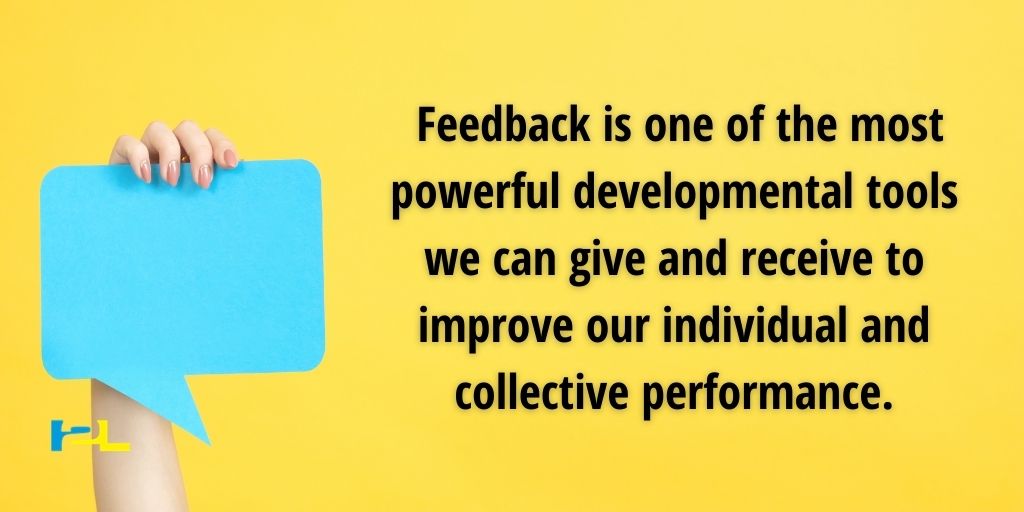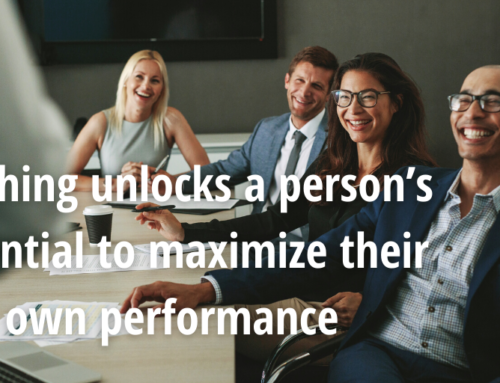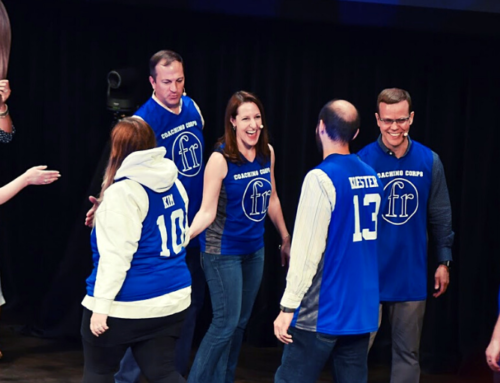Do you ever dread giving feedback…even when you know it’s important?
In the accounting industry, we have a contentious relationship with feedback.
Deep down, we know that exchanging feedback, which is simply information regarding prior behavior, can serve as a catalyst for performance improvement.
Yet, if we know this, why do we dread it so much? Why do we see it as something we have to suffer through, rather than the benefits it provides?
When we asked accountants to share the first words that come up for them when they think of exchanging feedback in the workplace, here are some of the positive responses we received:
- Motivating
- Helpful
- Important
Here are the negative responses we received to the same question:
- Uncomfortable
- Awkward
- Ambiguous
- Inconsistent
- Time-consuming
- Scary
Isn’t this interesting? Feedback is an exchange of information designed to improve performance. Yet, more people view the feedback process at their organizations as having a negative impact on their life. Something that should be supportive for growth is instead perceived as negative.
It gets worse.
Too often, we hear the following: “If I’m not receiving feedback, I assume I’m doing okay,” or “No news is good news.” These comments are usually shared in a disappointed, deflated tone.
Why do these people sound so sad? Statements like these usually indicate the following aspects of a feedback culture:
- Most, if not all, feedback exchanged is negative. “Since feedback is bad, I’m glad I haven’t received any.”
- Open communication is discouraged. “I’d rather not talk, so I can continue to assume I’m doing okay.”
- In the absence of communication, people make assumptions. “I don’t know how I’m doing, but since I haven’t heard anything, I assume I’m doing okay.”
- People feel disempowered and demotivated, since all they have to aim for is “doing okay.”
Feedback does not have to be awkward, ambiguous or sad! Feedback conversations can provide amazing opportunities to:
- Embrace our humanity by welcoming vulnerability.
- Practice coaching techniques that empower growth in others.
- Connect at a deeper level with one another through shared learning.
However, to unlock these opportunities, we must change the way we see and do feedback. Here are four ideas to do just that.
1. Embrace a more empowering mindset.
A mindset is a set of beliefs or attitudes. These beliefs are manufactured by the mind based on your upbringing, experiences and the accumulation of (mostly unchecked) thoughts you’ve assimilated over time. A mindset is a lens through which you see the world. It is the birthplace of your actions.
How you see the world (your mindset) affects what you do in the world. Therefore, your mindset creates your reality.
If you tend to view feedback through a negative lens, let’s start by examining your beliefs about feedback with the following questions:
- How do you view feedback?
- How do you view others with whom you exchange feedback?
- How do you view your role in feedback?
If you think feedback is difficult, awkward and problematic, you bring negative energy to feedback conversations.
If you see other people and their challenges as problems that need to be fixed, you will want to get the feedback conversation over with as quickly as possible. The person on the receiving end will feel like they are a problem.
If you see yourself as the bearer of bad news, you may procrastinate on checking this unpleasant task off your to-do list.
To do feedback better, you must first see it differently. You must shift your mindset to one of an investor!
Two core beliefs comprise the investor mindset. The first is:
I believe in every person’s ability to continually learn and grow (including my own).
When we value all experiences – the successes and the struggles – as an opportunity to learn and grow, we realize them as the gift they truly are. We welcome mistakes as vehicles for learning and progress. This belief strengthens our resilience when times get tough.
This belief also challenges us to notice how we view our colleagues. If you view a colleague as a problem, or as someone who is broken or incapable of change, you limit the possibility of growth for them.
Think of someone you believe is incapable of change. How does this belief impact your interactions with this person? Does it create friction? Does it limit what you talk about with them?
When you show up to a conversation with judgment about the other person, they will sense this and close themselves off to you and your message. Whether consciously or unconsciously, they will resist you and the feedback you are proposing. (Isn’t this fascinating? The way we view someone actually perpetuates the beliefs we have about them!)
Instead, what if you simply accept that we are all flawed and also capable of making improvement? How might this new belief impact your feedback conversations?
Take a moment to reflect on your own experience. Has there ever been someone who believed in you – someone who believed you could do hard things, things that you may not have believed you could? (I hope so!) What difference did that make for you?
The greatest gift we can give another human being is to accept them as they are and believe in their potential for growth.
The second core belief of the investor mindset is:
I am committed to my colleagues’ growth and will have regular conversations about their performance.
An investor invests time and energy today to pave the way for a better future. An investor cares about how others are doing and actively supports them today to ensure they receive the development they need to thrive for the long-term.
Think about someone who has invested in you and your career. Did you deeply appreciate that person? Don’t we all need people who are willing to invest in us?
Imagine how embracing an investor mindset could shift your thoughts and approach to feedback. It could enhance the dynamics of your relationships dramatically, creating a deeper level of collaboration and trust. By investing, you can make a significant difference in the lives of others!
2. Model effective feedback relationships at the top.
Nothing crushes a culture of feedback more than a group of executive leaders who don’t seem to acknowledge the need for it.
How often do your executives talk about feedback and its importance at your organization?
What kind of energy and passion do they exude when they talk about it?
Words must be followed by meaningful action. Do executive leaders invest in others by engaging fully in feedback conversations? Do they openly solicit feedback on their own performance?
When executive leaders get vulnerable and participate fully in the feedback process, they create the psychological safety for others to do the same.
3. Start with what’s working well.
Why should we start feedback conversations with the positive?
Because it’s where the good stuff is!
Correcting someone’s mistakes is helpful, but helping them understand what they do well can be even more helpful. You can help them identify their strengths! Our human potential lies in our zone of strength. It’s where we feel most alive, do our best work and expand our positive impact.
An investor helps the performer identify what they’re doing well because it:
- Helps them understand what they should continue doing. Human beings do not automatically repeat what we do well in every situation. We must shine the light on our positive behaviors, so we notice and intentionally continue them.
- Challenges them to stop seeing feedback as something negative. Accountants are often hired to find things that are wrong. You’re trained to find the errors. (Just think about the last time you received review notes. How many said something positive?) Seeking out errors can become a mindset – a mindset that damages the feedback process. You must focus on what is going well, too, so your feedback provides a complete picture of performance.
- Eases the way for constructive observations. If I know you’re seeing all of me (not just my errors), I’m much more open to learning where I can improve. I will be less defensive because I understand you’re not blaming or judging me. We’re learning together. We’re on the same team. You’re investing in me.
4. Stop delivering feedback. Coach instead.
Traditional feedback models focus on the deliverer of feedback (the person who delivers feedback to the performer of the work). The deliverer does most of the talking by sharing their observations and insights. The deliverer must provide insights that are timely, specific and digestible. When the deliverer feels 100% responsible for feedback, if they are feeling unprepared or uncertain of how the receiver will react, they will likely delay or even neglect providing the feedback. Valuable learning opportunities are lost.
We propose turning this traditional feedback model inside-out. Shift the responsibility for feedback from the deliverer to the performer. Shift the role of the deliverer from teller to coach.
Thanks to the mindset shift you’ve made, show up as an investor who believes in the performer’s ability to grow and learn.
Now, as a coach, facilitate a process for the performer to share their own perspective. Let go of the pressure to get it perfect. Instead, simply show up as a partner in learning to help the performer uncover their opportunities for growth.
Start with the performer. Instead of feeling like you have to have all the answers, simply ask questions to help the performer reflect on their own performance.
Step 1: Start with what worked well.
Ask open-ended, performer-centric questions focused on what worked well, such as:
- What did you do well on this project?
- What did you specifically do to make that happen?
- What did you learn?
Seek to understand the performer’s perspective about their performance. Actively listen, repeat what you heard, and encourage further observations. Continue asking questions from a place of curiosity.
After the performer shares their perspective, share yours. At this point, the performer has done most of the work, so simply endorse their observations where appropriate, and add your own. Note any instances where you may see things differently.
Step 2: Identify opportunities for growth.
Then, ask open-ended, performer-centric questions focused on areas for growth, such as:
- Where did you get stuck on this project?
- What did you find most challenging? Why?
- What would you do differently next time?
Allowing the performer to uncover their own challenges takes some of the pressure off you. It also encourages ownership, as the performer takes responsibility for their challenges and the related solutions.
Just as before, actively listen, repeat what you are hearing, and encourage further observations on these challenges. When the performer has shared all their observations, share your own – endorsing, adding to, and revising their observations where appropriate.
Step 3: Summarize the learning and identify action steps.
Next, ask the performer to clarify what they learned and uncover the action steps needed to improve their performance:
- What are you taking away from this conversation?
- What are you going to do next?
As before, actively listen, and encourage further observations. Then, endorse, add to, or revise their observations where appropriate.
This step ensures the conversation moves from insight to action. By asking the performer what comes next, you empower them to take responsibility for their further development. After all, it’s their career, isn’t it?
Step 4: Plan for the next conversation.
Before wrapping up the conversation, ask the performer, “When should we meet again?” Remember, as an investor, you committed to having regular conversations with them to support their continued growth. Asking this question creates momentum, consistency and accountability for continued feedback conversations.
Be sure to allow yourself and the performer time to adjust to these new ways of being and doing. This performer-based approach to feedback should awaken the performer’s observation muscles, so they will be more aware of their own successes and struggles for the next conversation you hold.
***
By flipping feedback inside-out – using a coaching approach that starts with the performer’s perspective – you not only change the process, you transform your relationship with the performer. You become an investor in their success! You move from a hierarchical relationship to a partnership, learning together. You create opportunities to connect at a deeper level, building trust. You unlock individual and collective potential at your organization.
Just imagine…instead of dreading feedback, you can create a culture where you and your colleagues actually look forward to feedback conversations!!
See you in the DoP,

P.S. If this sounds intriguing to you, but you’re not sure where to start, check out our Inside Out Feedback program in the I2L Learning Lab! This 4 week course pairs on-demand video lessons with practical assignments and handouts so you can immediately apply what you’re learning to make feedback something that inspires, instead of something you dread!

Original article published in the May/June 2021 issue of Texas Society of Certified Public Accountants’ Today’s CPA magazine.







